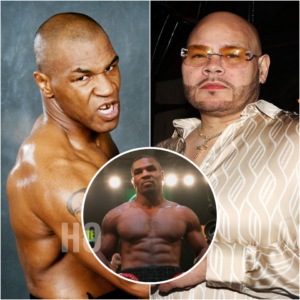(VIDEO) Jake Paul Reacts to Mike Tyson’s Muscular Physique at 57 Years Old: TYSON WON’T WIN | HO
The internet is buzzing with excitement as Jake Paul shares his thoughts on Tyson’s unbelievable fit appearance ahead of the Paul VS Tyson fight on Netflix this summer. Watch as Jake Paul provides his authentic, unfiltered commentary on Tyson’s jaw-dropping transformation.

The Spectacle and Ethical Dilemmas of Age and Showmanship in Boxing: The Mike Tyson vs. Jake Paul Debate
The impending bout between Mike Tyson and Jake Paul has stirred a whirlwind of excitement, debate, and ethical considerations within the boxing community and beyond. At 57 years old, Tyson is set to enter the ring against Jake Paul, a 25-year-old social media influencer-turned-boxer. This event has ignited discussions about the appropriateness of such a match, the physical risks involved, and the implications for the sport of boxing as a whole.
Mike Tyson, a legendary figure in boxing, known for his ferocious style and intimidating presence in the ring, retired from professional boxing years ago but has recently made appearances in exhibition matches. Jake Paul, on the other hand, has leveraged his substantial social media following to carve out a new career in boxing, taking on opponents with limited boxing experience and generating significant pay-per-view revenue. The matchup between these two figures from vastly different eras and backgrounds is seen by many as a spectacle rather than a traditional sporting contest.
One of the primary concerns raised by critics is the ethical implication of having a senior fighter like Tyson, who is nearly three decades older than Paul, participate in such a physically demanding and potentially dangerous sport at his age. Steve Ward, a former boxer who continued in the ring until age 64, has expressed apprehension about Tyson’s ability to withstand the rigors of a fight against a much younger opponent. He fears that if Tyson is compelled to restrain his power or if the fight is somehow manipulated for entertainment purposes, it might tarnish his legacy.

Eddie Hearn, a well-known boxing promoter, has voiced his disapproval of the fight, describing it as “disgusting” and indicative of the problematic directions in which the contemporary culture of spectacle over substance might lead the sport. His concerns reflect a broader anxiety about the integrity of boxing and the potential for exploitation inherent in such uneven matchups.
The health risks to Tyson at his age are substantial. Boxing, unlike other sports, carries a high risk of severe physical injury. Barry Hearn, another prominent figure in the boxing industry, has speculated that Tyson might only be able to perform at peak capacity for a short period before the physical demands of the fight overtake him. This aspect raises questions about the long-term health impacts for athletes, particularly older ones, who participate in high-stakes, high-intensity sports events.
Despite the ethical and health concerns, the market dynamics driving this event are robust. Jake Paul’s fights attract significant viewership numbers, reflecting a shift in the consumption of boxing from pure sport to entertainment spectacle. The involvement of Netflix in broadcasting the fight indicates a significant transformation in how boxing matches are viewed and monetized, emphasizing the entertainment value over traditional sporting competition.
The fight also represents a fusion of old media star power with new media influence, as Tyson’s legacy in the sport combines with Paul’s social media fame. This crossover appeals to a diverse audience base, expanding the reach and financial potential of the event beyond traditional boxing fans to younger, digitally-savvy viewers.
The much-anticipated bout between Mike Tyson and Jake Paul, set for July, has sparked a whirlwind of opinions, concerns, and excitement across the sports world. This fight, which is part boxing match and part cultural event, symbolizes more than just a clash of fists—it’s a collision of eras, reputations, and philosophies of sport.
At 58, Mike Tyson, once heralded as “the baddest man on the planet,” represents a bygone era of boxing—a time characterized by raw power, ferocious knockouts, and a brooding presence that filled arenas with both fear and fascination. Tyson’s comeback to the ring, however, is not just a revival of his athletic prowess but a reclamation of his enduring influence on the sport. His recent public appearances and training videos show a man who is defying the typical boundaries of age, conditioning himself to compete with athletes half his age, and rekindling the fiery persona that once made him a legend.
Jake Paul, on the other hand, symbolizes a new breed of athlete—one born of the digital age, where fame can be as much about your influence online as your skills in the ring. Paul started as a social media personality, known more for his antics on YouTube than any athletic endeavor. However, over the past few years, he has carved a niche for himself in the boxing world, taking his role increasingly seriously and earning respect for his commitment and improvement within the sport. With a professional record that, while still nascent, includes several knockouts, Paul has demonstrated that he is no mere sideshow but a serious contender willing to test himself against the very best.
This fight is draped in layers of controversy, primarily due to the stark age difference between the two combatants and Tyson’s long absence from professional competition. Critics argue that the risks involved for Tyson are too severe. The human brain becomes more vulnerable to damage as it ages, and the potential for lasting neurological harm from a fight of this magnitude is a legitimate concern. Forensic professionals and sports scientists alike have voiced apprehensions about the wisdom of allowing someone at Tyson’s stage of life to engage in such a potentially damaging contest.
Despite these concerns, the fight has also been framed as a testament to human spirit and the age-old adage that age is just a number. Tyson himself has shrugged off criticisms about his age and physical readiness, focusing instead on his training and mental preparation. His public displays of fitness and vigor are not just about proving his physical capabilities but are also a psychological game, reminding his younger opponent and the world that he still possesses the intimidating aura that once made him a formidable force in boxing.
From a technical standpoint, the fight poses an interesting matchup. Tyson, even in his prime, was known for explosive power and aggression, able to end matches with swift brutality. His style was all about overwhelming his opponents before they could find their rhythm. Jake Paul, whose boxing style is still evolving, tends to incorporate a more measured approach, using his reach and improving technique to wear down opponents over time. How these contrasting styles will play out in the ring provides a fascinating narrative for both boxing purists and casual fans alike.
The broader implications of this match extend beyond the physical contest. For Tyson, this fight is an opportunity to rewrite the final chapters of his public life, to shift the narrative from one of fall and redemption to that of enduring legacy and timeless appeal. For Paul, it’s a chance to legitimize his place in professional boxing, potentially elevating his status from novelty to a bona fide athlete in the eyes of the traditional boxing community.
Moreover, the event is set to be a massive commercial success, tapping into the pay-per-view and streaming markets, with promises of reaching millions of viewers who span generations of boxing fans. This fight is not just a sporting event; it’s a cultural spectacle, reflecting the evolving nature of celebrity, sport, and entertainment in the digital age.
In conclusion, as the fight approaches, the tension, excitement, and speculation will only amplify. Whether viewed through the lens of sports science, entertainment, or the legacy of two very different kinds of fighters, this bout is poised to be one of the most talked-about events of the year. It challenges our perceptions of what is possible, both in sport and in life, and regardless of the outcome, it will undoubtedly leave a lasting imprint on the cultural landscape of boxing.
News
“Fucking nightmare, Iron Mike chased me round a car 20 times, thought he was gonna kill me”: Fat Joe talks about a crazy story about Mike Tyson!😮💨 | HO
“Fucking nightmare, Iron Mike chased me round a car 20 times, thought he was gonna kill me”: Fat Joe talks about a crazy story about Mike Tyson!😮💨 | HO ‘We about to get knocked out’ Rapper Fat Joe shares a…
HO – ‘WHAT?’: Olivia Dunne shares Taylor Swift Travis Kelce TikTok after starring alongside the Chiefs Super Bowl winner in energy drink commercial
HO – ‘WHAT?’: Olivia Dunne shares Taylor Swift Travis Kelce TikTok after starring alongside the Chiefs Super Bowl winner in energy drink commercial Olivia Dunne has shared a hilarious behind-the-scenes TikTok featuring Travis Kelce and referencing his girlfriend Taylor Swift after the pair starred in a new…
HO – Travis Kelce to compete with Chiefs teammate Patrick Mahomes as the duo earn Nickelodeon Kids Choice Awards nominations… while tight end’s girlfriend Taylor Swift also gets a nod
HO – Travis Kelce to compete with Chiefs teammate Patrick Mahomes as the duo earn Nickelodeon Kids Choice Awards nominations… while tight end’s girlfriend Taylor Swift also gets a nod Travis Kelce will compete against his running mate Patrick Mahomes for a Nickelodeon…
HO – WNBA game between the Chicago Sky and Indiana Fever that featured the controversial foul on Caitlin Clark averaged over a MILLION and a half viewers – an over 300% increase from 2023
HO – WNBA game between the Chicago Sky and Indiana Fever that featured the controversial foul on Caitlin Clark averaged over a MILLION and a half viewers – an over 300% increase from 2023 The WNBA‘s Chicago Sky-Indiana Fever game that featured…
HO – “All Good”: Caitlin Clark Had The COOLEST Reaction To Being Called A “White B****” By Pat McAfee
HO – Caitlin Clark Had The COOLEST Reaction To Being Called A “White B****” By Pat McAfee Caitlin Clark has offered a reaction to being called a “White B-” by Pat McAfee, according to Pat Mcafee himself. The ESPN show host crossed a line…
HO – NFL Fans Are Worried About Tua Tagovailoa After Shocking New Photo Emerges Of The Dolphins Quarterback
HO – NFL Fans Are Worried About Tua Tagovailoa After Shocking New Photo Emerges Of The Dolphins Quarterback Tua Tagovailoa has been the subject of many conversations this off-season after the Miami Dolphins were knocked out of the NFL playoffs in the…
End of content
No more pages to load











